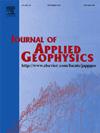Self-potential gradient inversion based on a hybrid weighting strategy
IF 2.1
3区 地球科学
Q2 GEOSCIENCES, MULTIDISCIPLINARY
引用次数: 0
Abstract
Self-potential (SP) signals serve as intuitive indicators for identifying subsurface natural current sources. However, this simplicity is offset by the significant challenge of source imaging. Sensitivity-based model weighting approach has limited capability to prevent the skin effect, and measurement errors arising from inappropriate reference positions can lead to distorted source interpretations. To address these challenges, we develop an SP gradient data inversion method based on a hybrid weighting strategy. Three synthetic examples indicate that the hybrid weighting method generally outperforms the individual sensitivity and depth weighting strategies under varying media and source conditions. The underlying mechanisms are analyzed in detail by comparing the model weights, initial models, and integrated sensitivities within the existing focusing inversion framework. Furthermore, we investigate how variations in SP polarity impact source interpretations, reveal the potential distortions they may introduce, and prove that such effects can be effectively mitigated through the SP gradient inversion. The proposed approach is also validated by a laboratory experiment of a naturally polarized Cu![]() Fe sphere. Both the synthetic and laboratory results demonstrate the superiority of the proposed method in SP source imaging and highlight its potential to deliver valuable insights for reevaluating SP anomalies in environmental and engineering applications.
Fe sphere. Both the synthetic and laboratory results demonstrate the superiority of the proposed method in SP source imaging and highlight its potential to deliver valuable insights for reevaluating SP anomalies in environmental and engineering applications.
基于混合加权策略的自电位梯度反演
自电位(SP)信号是识别地下自然电流源的直观指标。然而,这种简单性被源成像的重大挑战所抵消。基于灵敏度的模型加权方法防止集肤效应的能力有限,并且由于参考位置不合适而产生的测量误差可能导致源解释失真。为了解决这些问题,我们开发了一种基于混合加权策略的SP梯度数据反演方法。三个综合算例表明,在不同介质和源条件下,混合加权方法总体上优于个体灵敏度和深度加权策略。通过对比现有聚焦反演框架下的模型权重、初始模型和综合灵敏度,详细分析了其机制。此外,我们研究了SP极性的变化如何影响震源解释,揭示了它们可能引入的潜在扭曲,并证明了这种影响可以通过SP梯度反演有效减轻。该方法还通过自然极化CuFe球的实验室实验得到了验证。合成和实验室结果都证明了该方法在SP源成像方面的优越性,并强调了其在环境和工程应用中为重新评估SP异常提供有价值见解的潜力。
本文章由计算机程序翻译,如有差异,请以英文原文为准。
求助全文
约1分钟内获得全文
求助全文
来源期刊

Journal of Applied Geophysics
地学-地球科学综合
CiteScore
3.60
自引率
10.00%
发文量
274
审稿时长
4 months
期刊介绍:
The Journal of Applied Geophysics with its key objective of responding to pertinent and timely needs, places particular emphasis on methodological developments and innovative applications of geophysical techniques for addressing environmental, engineering, and hydrological problems. Related topical research in exploration geophysics and in soil and rock physics is also covered by the Journal of Applied Geophysics.
 求助内容:
求助内容: 应助结果提醒方式:
应助结果提醒方式:


